The road to Texas took me to a place from which I can't return. Or rather, part of Texas has returned with me and it's here to stay.
I usually drive Highway 10 on the way to Joshua Tree or Las Vegas. This time, Sean and I followed it all the way to Texas. All the way to Houston, to be precise, on the far side of the state on the humid green Gulf Coast. The route is a fine cross section of the Southwestern United States, both land and people, and I wasn't even traveling to see the country. The purpose was delivery of a cargo van full of test equipment to the Low Gravity Laboratory at Ellington Field, subsequent installation and operation of that equipment on a NASA KC-135 aircraft, and safe return to Pasadena. It was a wonderful perk to the job: there is no better time to educate one's self, or to create, or to formulate ideas, than when occupied by unrelated business. I come up with most of my solutions while daydreaming through some other event. I isolate my most conclusive observations when not looking for anything in particular - it is then that I happen to see a connection that explains some puzzling behaviors or links cause and effect. I've found a taste of Texas and the southwest, collected in passing. Go back and I'm sure you'll find it different, but here's my story:
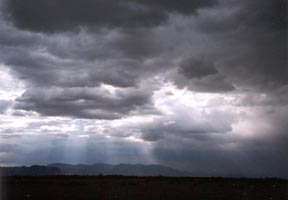
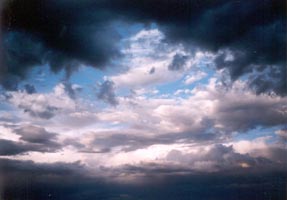

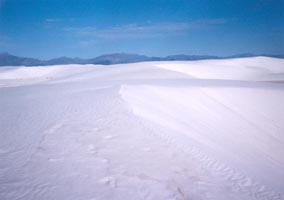
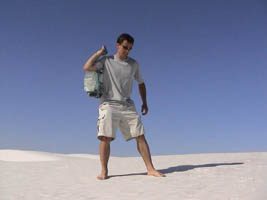
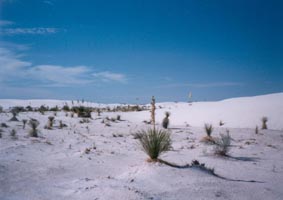
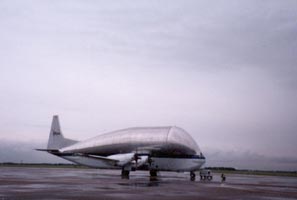
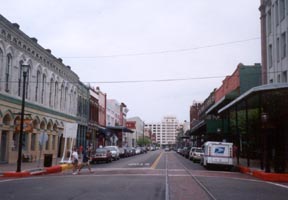
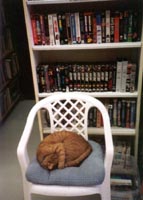
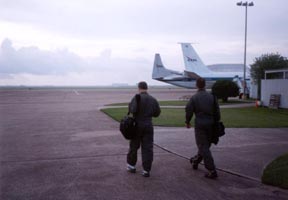
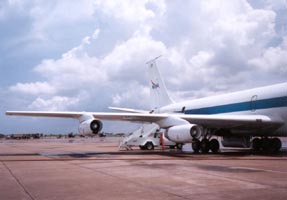

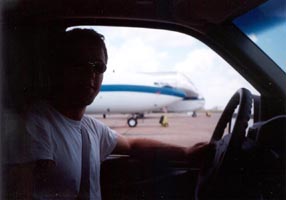
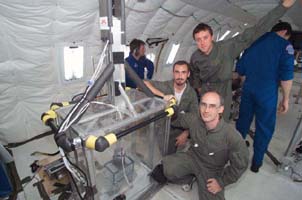

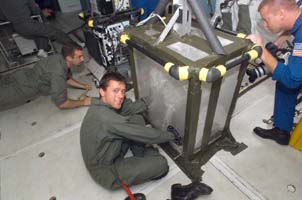
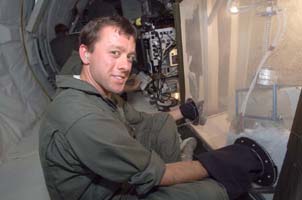
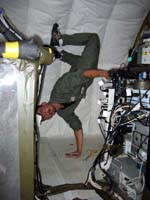
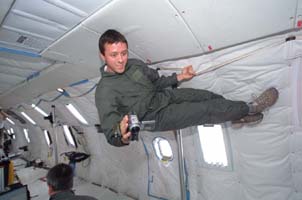
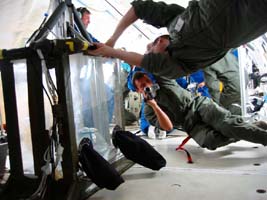

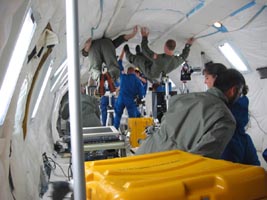
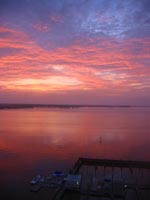
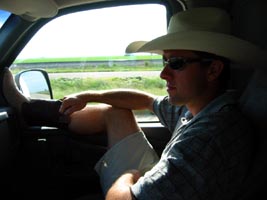

The view in my mirrors when we left Pasadena was of the usual gray June haze and drab green desert hills Ahead of us was the familiar route Eastward, a monotonous drive to Arizona that I'd done before. Arizona highways are superior to any other state I've visited, though New Mexico does a fine job as well. Concrete and steel overpasses are tinted and painted red and tan desert colors with bright mosaics and Southwestern designs, medians and roadsides are carefully landscaped with desert plants and groomed gravel, and the road surface is well maintained and marked. We passed Phoenix and drove into empty hills, passing undistinguished small towns and a hollow and industrial looking collection of mid-rise buildings in Tucson. After Tucson the scenery improved, with more mountains but few signs of life. The clouds had persisted overhead and we began driving through rain showers with intermittent lightning.
It was a plain travel day of Subway sandwiches, Dairy Queen drinks, and dinner at a mediocre steakhouse in the town of Deming, New Mexico. The salad bar had few vegetables, my medium steak arrived very well done, my steamed peas were olive green and mushy, and the spiced cider tasted like it came from a powdered mix containing nothing that had ever been part of an apple tree. The restaurant was a family place where people came to dine out for a change in diet, a treat I presume though I found nothing worthy of a return visit on my plate. I wondered what it would be like to know only that restaurant and nothing better. We drove on after dark, willing to push ahead rather than stay in a place so depressingly limited in goods, skills, and dreams.
At dawn we were in Las Cruces, at a Holiday Inn that claimed to have the largest conference facility in the city. It was a presentable hotel with several ballrooms but no remarkable selling point other than the probable distinction of being one of just two or three such places in southern New Mexico where a large meeting could be held. The sky was clear and blue and we were in new territory, so we set off to see White Sands National Monument. The dunes aren't common beach sand but rather small crystals of gypsum that would dissolve and leach away in wetter climates. The crystals were flat, some twice as long as ther were wide and most wider than they were thick, and they clung together even though the sand was dry. It had rained the night before - we'd been driving through the storms - and puddles reflected the dazzling white landscape. Heaps of sand had been thrown up on the roadsides by plows, looking exactly like a New England road after a light snowfall. Dunes stretched into the distance, uniform white with sinuous spines. Between dunes there were flat hard-packed areas where withered grasses grew, some of the few plant species that can grow fast enough to reproduce before becoming buried by the always-moving sand. There are also white lizards and white foxes and other specially adapted animals in the area but we had arrived near midday when all sensible creatures were laying low in shady places.
Man is not always a sensible creature though; our progress onward was delayed by a missile test. The road was closed while a missile was fired twenty miles away; all we saw was a puff of smoke. Dozens of vehicles had been stopped and the people of the desert had gotten out of their cars and trucks and were shuffling around. One man seemed to suspect that we were government agents of some sort, at the very least "evil government scientists." I neither supported nor refuted his speculation. A family of large people hovered around a bush of buzzing cicadas. They all wore only black: black jeans, oversized black t-shirts with rock music logos on them, wallet chains and leather bracelets. The bits of conversation I overheard from them did not seem to be particularly insightful to the world around them. Perhaps they were simply expressive in that way, but to me there is nothing commendable about taking a lifestyle so devoid of culture and well-being. It does no harm, except perhaps by perpetuating the role model, but it gives little. The angry dark dressed metal rock people do balance the scholarly followers of culture; I supose that alone lends stability to society. Nearby a woman with a mullet haircut proved to us that the 1980s had not been forgotten, no matter how many bad fashion ideas were generated in that time. The inquisitive man who had peered into our rear windows stopped to chat again. In thirty years he'd never been delayed by such a test, even though our Park handout said they occur on average twice a week on this main road through the area. I wondered if that said anything about how often he took a day off work and did something different for a change of pace, chancing an encounter with a roadblock. It was probably not often.
El Paso is not far from Las Cruces, only half-way across New Mexico. Only half-way through our drive we were already in Texas. Upon crossing the border, the road surface quality immediately disintegrated to a surface broken by rumbling cracks and potholes. We sped along through barren desert under a gray sky. Wisps of rain fell from the clouds but evaporated before reaching even a third of the way to the ground. Farther on there were sprinkles on our windshield, and the land was a bit greener from the moisture. We entered scrub land at about the same time that heavy squalls began battering our windshield, lightning playing in the sky all around us. The scrub became taller and dry grass appeared among the trees, and then there were real trees and steeper hills and limestone outcrops. We were in cavern country, a land of layered limestone and rain and abundant greenery. Highway cuts revealed layer-cake strata of ivory and tan and gold. White blocks lay scattered beside a crumbling stone barn where a wall had collapsed. It reminded me of Arequipa, Peru, "ciudad blanco" where even the crude peasant huts normally built of mud brick were lent an appearance of richness by bright limestone blocks cut from the local bedrock. There were creeks and waterfalls and lush pastures. Occasionally we would pass a windmill of a barn roof peeking through the trees on an adjacent hillside, but for the most part there was no sign of habitation but fences. I wouldn't mind having a ranch there in the limestone hills, if I was content to live with the isolation. Some day I'll have finished the city tour, found enough excitement, and returned to a quiet place.
We'd heard that San Antonio was a nice city so we hurried there, arriving at dusk and locating a hotel near the River Walk. A small river runs through the city and at some point early in city planning, wise designers had dug a channel loop several hundred yards long and flooded it about 10 feet below street level. Both sides are paved with flagstones and planted with flowers and massive trees. The water is dark and motionless and probably best seen only after dark when twinkling lights and restaurant fronts shimmer in the ripples. Buildings immediately beside the river rise 15 or 20 stories. There are arched bridges, fountains, and dozens of fine restaurants with waterside seating. We ate an amazing dinner at a steakhouse. My $12 kebab arrived with 10 ounces of thick tender beef in chunks the size of flattened tennis balls, and excellent mashed potatoes with roasted garlic and seasonings and beans and grilled gegetables. A good dinner makes a good day. Afterward we completed the loop walk. It was late, especially with the 2-hour time change from California, and most of the restaurants were closing. The river walk was entirely restaurants; there were no retailers or very few at least and the handful of restaurant/bars that remained open were not particularly busy. It seemed to be a place for fine dining and boat tours for couples or families rather than a party town, though there were three giggling young women on a hotel balcony some 8 floors up who had lost some clothes - it was a warm steamy evening - and, perhaps encouraged by a few drinks, were prancing around and calling to us as we walked below.
We got a room on the clubhouse floor, the floor for which you had to swipe your key card in the elevator just to get there. The beds were cushy, the furniture elegant, and the interior decorations nicer than a typical city hotel room. We must have been given a last-minute discount checking in at 9pm, because the cost was little more than I'd have expected to pay for a simple room at a plainer hotel. My bed had seven pillows. The complementary breakfast in the lounge - card swipe also - had fruit and muffins and pastries and cereal and juice and more fine furniture and an attendant to clear the dishes and chat with us about the news we were watching on CNN. I'd yet to encounter anyone in Texas who was adamantly pro-Bush, and I'd heard several already who were hesitantly disagreeable with the administration's policy. We were in the city though, not the real rural Texas. We had driven through visibly conservative areas: an unassuming rectangular single-level church beside the interstate was dwarfed by a massive forty foot tall cross lit by brilliant floodlights in the lawn. Pro-life signs occasionally appeared. Every "Don't Litter, $1000 fine" sign was accompanied by "Don't Mess With Texas" in bold letters and once we passed a faded sign - a highway sign, not a billboard - that said only "Don't Mess With Texas."
The Alamo was closed when we stopped by at 8 in the morning but even so, it was easy to reach the top of the fortification's outer wall and hoist myself up and peer in. I wondered how such a low structure could have repelled attackers. I suppose any kind of wall is good to have for protection, and of course in the end it didn't hold. It was built as a mission, not a fort. Back on the road, we passed some scattered suburbs of enormous houses but saw none of the sprawling metropolis I'd expected to find around a large city. Soon the pretty limestone hills were behind us and it was raining again, gray clouds sitting at the treetops and mist from rigs ahead fogging the windshield. I'd had too little sleep and the weather wasn't helping so I exited the interstate to seek caffeine in some form. The Dairy Queen was closed for 10 minutes more when we arrived so I drove off through the tiny town of Weimar to see what it had to say about itself. The main street looked like a scene from an old Western. The storefronts were dilapidated but unchanged. Few people were around and there was only one restaurant, a Mexican cafe. I bought a chocolate milk at a gas station, putting my first choice back on the shelf because the sell-by date had passed 18 days earlier.
We found familiar roads at last in Houston, 1800 miles from home. Sean would have gone straight to the airfield to unload our equipment - I've found few people who like to have three meals a day like myself - but I drove us to a deli, passing up the Quiznos across the plaza for the unincorporated, unfranchised, better food, better service, less packaging, cute waitress L&L Deli and it's tasty grilled chicken sandwich. We picked up our badges and drove the van onto Ellington Field, parking at the Low Gravity Lab and unlading our gear while fast little NASA T-38 jets and faster black Coast Guard jets roared into the sky not far away. The glowing orange and pink afterburners on the Coast Guard jets made our building resonate and were so loud they seemed to tear the air apart. Outside a Super Guppy was parked, looking comically swollen beside our KC-135. Some other NASA jets, a DC-9 and a U2, were in a hanger next door. We got the equipment checked out and mostly assembled before the lab staff went home at 4:00.
It was time, after we got our rooms, to find what the town had to offer. I drove first to Kemah, a "weekend destination" -the billboards said - of restaurants, shops, bars, and carnival games. Across the channel from the boardwalk - actually in the town of Seabrook - we ate at Papa Deux. We'd arrived a bit before the dinner crowd so no one was outside the front double doors when we approached. Then suddenly two very cute red-shirted young hostesses appeared from inside and stood smiling, holding the doors and ushering us in to their lair of love - or so it seemed, at first reaction (immediately inside I found myself staring at a lobster tank.. back to reality). The food was good - lots of cajun on the menu - and the restaurant popular judging by the crowd that arrived later. On the way out, driving to the street, we passed a pink building that housed a bar surrounded by a few trucks. Maybe later, we said. First, the Boardwalk. There were people about but not much was happening. There was some live music, Joe's Crab Shack was busily serving drinks but not quite filled with people, There was another band in the open fountain plaza, and everyone seemed to stay within their groups. The demographics were worth commenting on: almost entirely caucasion, a wide mix of ages, typical of the area I assumed until a boat went past with only black people aboard and a party under way. We continued to notice this separation, even more dramatic than in Los Angeles. People didn't just cluster together with like ethnicities; they separated themselves geographically. I wonder why?
In spite of the southern latitude the sun set late, at 8:30, so it was just getting dark when we went back to the pink house. It was a Texan dive bar with country music and cigarette smoke and locals who all knew each other stopping in for drinks and chat, pool and card games going, photos and postcards on the walls, and one couple dancing. I talked to a Coast Guard officer from Oklahoma who lived in the area. He recommended a few destinations just down the road. After a bit Sean and I moved on, finding the Beach Club parking lot full of cars and nearly everyone inside 20-something. So that's where they all were.. The dj was seeking recruits for a wet t-shirt contest. The club has a lineup of events designed to allow women to lose their tops - shadow box contest Saturday, pudding wrestling Wednesdays, and a bikini contest Sunday afternoons with a thousand dollar prize. The cover was $6 Friday night and $3 on Sunday, and though we never stayed long enough to see a contest it seemed that there were plenty of people living a continuous spring-break-party lifestyle to keep the profits rolling in.
Saturday morning we emerged into another hot cloudy day and drove south to Galveston. The neighborhoods there were predominantly black, a notable difference from the Clear Lake area, and beautiful. The historic district was centered around The Strand, a waterside main street of shops and cafes and bars. At the door to a used book store an orange cat sat staring out at the street. Later when we came into the bookstore - used and rare books - the cat had curled up on a chair with a paw flund across its eye to hide from the light. When I touched it's back, the cat scrunched up tighter: "go away and leamme alone! I want to sleep." I bought a book on Depression-era classic Texas cooking. At a military surplus store I bought a NATO-issue green canvas rucksack, planning ahead for trips into North Africa and east-central Asia where Kelty screams American or look-at-me more than anything else. Also there I procured a Columbian machete, a well-balanced blade of quality one can't buy American (or rather, American mass import) made. There's no need for it in Pasadena, but I'd take it and a water purifier next time I go to the South Pacific. Some old buildings were being renovated and others, off the Strand, were in the rotting moist state of old Gulf Coast structures, elegant despite their mossy clapboards and dark wet trim. There were some bars that looked like good evening hangouts but it was morning and our parking meter was running out so we returned to the van and drove the wrong way onto one-way streets (empty) twice before getting settled on the road North.
I'd picked up a flyer in the hotel lobby about the Houston museum of Natural Science and the IMAX theater there. With minimal knowledge of its location we navigated to the museum district southwest of downtown and got tickets for a 5:00 show, by then an hour and a half away. We browsed the museum exhibits and got through just a part of them before watching our film. It ended up being a disappointing film, the Science of Adrenaline, having not quite lived up to my expectations. It had only two themes: skydiving and base jumping. The plot focused on an experiment to test a pyramid-shaped chute drawn by Da Vinci but never tested. The first drop test was human from a balloon, starting with the chute inflated, and the though the chute remained inflated and seemed to stay with the accompanying parachutists using conventional chutes it never was allowed to land (the most important part!) - the test jumper cut away. Even lacking this critical test of function, it is interesting that Da Vinci's chute didn't collapse. It speaks to his insight; parachute design is very much non-trivial. The rest of the film mixed shallow drama and entry-level science with silly animations and over-exuberant music among some spectacular base jumping shots from a 4000 foot cliff in Norway. I would have enjoyed the film more if the 45 minutes of big screen action had been a narrated montage of fast-action sports like whitewater paddling, biking, skiing, bungee jumping, parasailing, kiteboarding, and so on.
Having made passage through a number of low-ceiling parking garages we had attemted to enter the museum garage, finally verifying the height of our van at more than 6'8" (but les than 7' according to earlier gates). It had been nerve-wracking rolling through garages with four inches of clearance to the concrete beams and pipes. Instead we parked in the Houston Gardens next door. They looked pretty... a wedding reception was leaving when we arrived. Also in the museum district was a fine art museum and, not far down Main Street, Rice University. After the film we looked for tall buildings and drove to them, winding through the center area of downtown to see if it was worth stopping at. I would have gone on - it was dead quiet and there didn't seem to be much to do but get dinner, and there was a possibility of joining two wedding parties at our hotel, but Sean suggested that we get a drink at an Irish pub. There the bartender said it would get busy later, around ten. It still seemed a stretch. Main street has a new metro service and is closed to cars along five or six blocks. It is there (and on adjoining blocks), along brick paved streets with an ingenious fountain shooting leaping arcs of water over the tracks except when trains passed, that 15 or 20 restaurant/bar/pub/club establishments bring in the evening crowd.
Seeking dinner, we went to Mia Bella Trattoria. It was one of the few places that was busy at 7pm and we had to wait at the bar and talk over glasses of wine. The food was amazing, well presented and tasty and very reasonably priced considering the setting and service. Outside, traffic increased and the sun set. After paying our bill we made a round of the main stretch of activity and were encouraged by promo-card distributors outside every other club. There was another Irish pub across the street from the one we had visited earlier and it had been quite active earlier but had quieted down a little. We went in and learned that a private party was going on upstairs - advertised as "Reddish fetish, invitation only" - but it would open to everyone at 10pm, in 10 minutes. We played a game of pool and talked with the waitress and eventually made our way upstairs, where the doorman was still trying to stretch the invitation only power of regulation I presume to keep out guys who hadn't talked to someone about getting in first. Inside there were some remnants of the reddish-fetish more-sexy-than-usual female attire including one girl who was being airbrushed instead of wearing clothes. It wasn't really body painting though - the color was not bold or opaque enough and really she was just walking around mostly naked looking a little unhappy. I suppose her friends put her up to it. Poor girl; every comment I heard was 'so pretty' when in fact she would have been more enticing in a cute dress. I suppose it's all personal preference though. Tom, a 40-something divorced machinist I met on another business trip, told me over lunch one day that life was really "all about money, power, and lust" once one got past nonexistant ideals to the reality of middle life. He's the self'described "good 'ole American boy, none of this micro-brew or import beer, keep it simple" type of person, probably quite similar to many of the Texans on Main Street that night.
The party inside increased in numbers and intensity and the party outside boomed to fill the entire street. Every club had a crowd and most had lines, as we could see from our balcony. Far from residences, on a street without cars, the party became a street event with music audible outside and crowds of people on the move. I missed California's no-smoke laws and spent a fair amount of time on the balcony, where the music shook the wall behind my back and the city lights shimmered on glass facades. There I struck up conversation with Mark the traveling sex toy specialist who was hanging out after the earlier party. He had been married 24 years and in the business 23 years, doing all private parties and advertising by word of mouth. I wonder how one would get into that business. Apparently there are groups and websites and gatherings - I avoided the details - and a wide variety of sensory devices (if I may so describe them). The colorful glass bulbs of wispy ionized gas that give small static shocks when touched, typically seen at parties and in science catalogues, have been fitted with handles and shaped into toothed rakes and pads for giving odd massages. Toothpick-like steel claws with fingertip clips provide a tingling sensationwhen dragged across the skin. A teacup-sized suction cup with pump is designed to do something to women (there are two sizes). Then there was the rubber hand. Everyone at the bar seemed to be as unaware of and intimidated by the things as I was, intrigued by the static zappers but leary of everything else.
It was nearly 2am, when the bars would close, and it seemed that most singles had either moved on or paired up (the former seemed more common) so we went out past the couple apparently having sex by the doorway to see what the other clubs were like. There were about 6 very busy clubs with lines snaking down the sidewalk or throngs of people milling around outside. Then there were many more smaller bars, restaurants with bars, and quieter clubs. Music throbbed everywhere around us and uniformed officers walked back and forth. I asked one if it was a typical night and he said, "yes, for a weekend." I bet one of the officers' major roles is to keep people off the train tracks. We walked up the street and noticed a remarkable separation of ethnic groups. One club was emptying out and entirely people of African descent. A couple doors farther on was a club popuated entirely by people of Asian Indian or similar background. The clubs two blocks away were mostly caucasion with some Asians. In Los Angeles, for comparison, people live in segregated neighborhoods but they party together.
Shortly after 2am the floodgates opened and a thousand or more people were on the streets, going home. Most looked to be between the ages 20 and 30. We returned to the van and headed out of the city, taking wrong turns and mystery exits and becoming thoroughly lost and nearly running out of fuel before finding an open gas station and the right Interstate and Clear Lake.
Sunday was to be a work day, but between the Beach Club and a fine little coffee shop where there was a back room with whiteboard we didn't get as much done as planned. Tom arrived, and the next morning we finished setting up the test equipment and loaded it onto the airplane. We had dinner at the Crazy Cajun - more bacon wrapped cheddar jalapeno stuffed shrimp - and did more planning at the coffee shop, where a youth church group was sitting in a circle clutching their "Jesus" books and discussing ways to be better people. We had to sit out front because our whiteboard room was filled with older women watching a presenter talk about what seemed to be a lesson on aging, chemistry, and remaining motivated, healthy, and happy. Two teenage girls chatted at a table behind us and other small groups of people came and went throughout the evening while we planned flight activities.
I expected to be a bit of an anomaly when I stepped out of my room Tuesday morning wearing my olive green flight suit. But one floor down Sean got on wearing his flight suit, and in the lobby there was another man wearing his flight suit but for an entirely different program. Two more soon joined him, and we all congregated again at Starbucks. It's Space Town all right. We got meds and a preflight briefing, then did final preparations for flight. I was late to choose a seat at the rear of the aircraft so I ended up sitting in the boomer seat, behind the pilot on the left side of the aircraft across from the flight engineer. The KC-135 was built as a refueling aircraft and the boomer goes aft and flies the refueling boom. I listened in on the pre-flight checks and marveled at the hundreds of switches and lights covering the cockpit panels. We took off and climbed sharply and were freed to move about just a minute after leaving the concrete, when the aircraft was still tilted enough to make it hard to walk uphill. Fifteen minutes later we lost gravity.
The KC-135 has four small engines, jets with small fans and no bypass ducts, and they are so loud that we had to wear earplugs. That made communication somewhat difficult, staying strapped down took some attention, and on top of it all I felt quite sick every 5-10 minutes for no apparent reason other than that my stomach was getting sloshed around in strange ways as we came out of zero g and into 1.7g. The transition in the other direction was difficult to notice. Things stayed put for a few seconds, then wandered away as the aircraft flew down around them. Our acrylic enclosure of sand was the most fascinating to watch of all the experiments. It was 36 inches tall, 30 wide and 22 deep with 5 gallons of sand and a sampling mechanism designed for use on comets and asteroids and small planetary moons. As I expected, the mass of sand crawled up walls and sloshed around in slow motion, swirling in vortices and heaping in a corner upon return to a gravity environment. The first day, we could only sample effectively when the pilot flew a 0.01g period for us, which he did approximately every fourth parabola. On the second day I felt much better and our pilot and weather were excellent; we began sampling as the acceleration dropped past tenths of g's into hundreths of g's and were usually finished filming by the time oscillations about zero sent the sand to the ceiling. The third day ended with some broken hardware that we removed and repaired late at night in Sean's hotel room, leaving bits of wire and plastic and metal shavings and sand in the carpet.
The periods of low gravity begin at the inflection point of a 45-degree sinusoidal trajectory when the accelerometers show a sudden change from 1.7g down to tenths of a g (the drop takes a couple seconds). People start to float immediately, having jumped up, but the pilot continues to ease the aircraft down slowly and approack zero g within a few hundreths. For the duration of the parabola, to the next inflection point, the accelerometers show fluctuations within a few hundreths of zero sometimes going negative especially later in the parabola. Then the sand settled contently on the ceiling and I often felt as if I was solidly upside down, an odd sensation since it was reached with no sensation of rotation. At the "feet down, coming out" inflection point, everything settled back to normal within a few seconds. The sand fell instantly from its amorphous fluid mass to a limp heap. The engines screamed into the dive and everything seemed deadened. If I was ever caught resting on my side, or any position but straight spine, I really felt the g's pull. It gave be much respect for military pilots flying much harder turns.
After flights we debriefed and made small modifications to the hardware, then retired for lunch to Pe-te's Cajun or the Outpost Tavern. Both are old pilot and astronaut hangouts with signed photos of astronauts all over the walls, space memorabelia and decals from dozens of research teams, and collections of beer cans - hundreds of different kinds. The Outpost Tavern serves hamburgers. No menu, no nonsense, just a plain thick juicy burger with greasy fries. They have pool and shuffleboard. Pe-te's Cajun is a cafeteria-style place with the same sort of space theme, barbecue and cornbread and potato salad and styrofoam cups and plates. It has a stage and a fairly large space for, I suppose, wild country dancing if that ever happens these days. The weather stayed cloudy with showers and periods of blue sky and heat. Always heat; air conditioned stores and restaurants felt uncomfortably cold. On the last day we flew some lunar and Mars parabolas and had opportunity to walk around under the reduced gravity. Imagine being buoyant as if you were in water, but having no viscous damper - I could have jumped half-way down the plane in one leap! Mars was a bit heavier - more than twice lunar gravity, at 38% of Earth's gravity. These low-gravity parabolas were more novel than the free-floating ones because the sensation was like nothing else I can describe. Floating is like falling, of for that matter like those floating dreams where you can fly your mattress around and sit up on the ceiling and speed along by willpower alone, but walking on the moon is something else entirely.
Repairs were made in Sean's hotel room. There we dismantled the sampler, cleaned the sand out of the bearings, and installed new components, doing our best to sweep up the sand and metal shavings from the carpet. On one trip back up from the van I had the cordless drill charger slung around my neck, the drill in one hand with a masonry bit, and an oblong grapefruit-sized rock in the other. A man joined Sean and me in the elevator as we ascended to our rooms. He was silent for a moment, eyeing us, and then said "dare I ask what you are doing with a drill and a rock?" I smiled and said "Well, you see, we're going back to the room to charge the drill so I can drill a hole through this rock, and then I'm going to tie a string to the rock, and tomorrow we're going to take it on an airplane and put the airplane into a steep dive so we need the string to tie the rock down so it won't float away..." Then we arrived at his floor; the man fled hastily with a confused smile. I think he was bothered because my explanation was so wild it could only be true.
After Friday's flight we unloaded the aircraft, packed up the van, and spent the evening at the coffee shop one last time hashing out design changes, future test plans, and experient observations on the white board there. A teenage Friday night crowd assembled there, outside our side room, and occasionally someone would linger at the door trying to figure out what th eheck we were doing. My sketching of brush wheels and sample collector chambers once took the form of Dr. Evil's spacechip - I shall describe it so, the first one, quite an accurate rendition - and when two girls sitting outside started giggling and inquired, "excuse me, but what is that?" I realized my error in making square corners round and sketching lazy proportions. Funny, those engineers so focused on work they become oblivious and comical. I also made the mistake of drinking coffee so I didn't sleep well, possibly also feeling effects from the motion sickness medication we were taking. To combat the sedative effects of the drug we were also given an amphetamine, which for most people caused alertness and a need for activity and productivity but for me had no obvious effect. At the end of the flights I just felt beat and drowsy.
Saturday morning was sunny and mostly clear, a change from the gray wet weather we'd had all week. After checking out, Sean and I drove north through Houston and continued to Austin, taking a different route home for a change of scenery. Austin was very quiet on Saturday. We ate some tasty burgers there and headed West into rangeland, taking rural roads through the heart of Texas. There are interregional highways in Texas, I presume because in a less expansive state such roads would be interstates. Then there are ordinary highways, typical two-lane roads. Smaller still are numbered county roads - which often are narrow and have no paint - and farm roads. Then there are dirt tracks. We threaded our way through them in a westward direction, stopping along the way to look for hats and boots. I felt that we would need those items to pass through central Texas and also that the only appropriate place to purchase them was in a small country town well away from an interstate. Sure enough, we came upon a ranchwear store about an hour northwest from Austin.
Texans are serious about hats. There are many grades of hats, felt and straw, the lowest for work and the highest, priced at $150 or more, for special occasions. There are many sizes too, and many styles, more hats than I had ever seen together in one store. We didn't see people wearing hats in the city at all, and even in smaller towns there were only a few hat-wearers. Boots also came in dozens of styles too, and the prices were surprisingly low. I walked out with both boots and hat, my pass to the countryside, ready to venture into rural Texas. Sean got a hat. The county roads were the best. We drove through farms and ranches scattered miles apart in the lightly forested grasslands. There were many fences but few animals in sight. We splashed through streams, bounced over potholes, skirted ditches and creeks, and skimmed tree branches leaning into the road. A mailbox was painted in the Texas colors and a Lone Star, and farther on the blades of a windmill were too. A Texas flag was painted on the side of a gray corrugated steel barn, weathered but still proudly proclaiming that in Texas, people were free, capable, and defensive of all that they had. Texas may be the only state in the Union where one will see more state flags than stars and stripes, though we saw both frequently and many signs and stickers saying "we support our troops and our president." The people were friendly (maybe our hats helped) and the countryside was beautiful, green, lush, and free from sprawling developments and roadways. Sometime about midafternoon we noticed that it was midafternoon and we were not even half-way across Texas, so we returned to divided highways and set out for Abilene, Amarillo, and finally Lubbock.
All of those towns were lacking excitement. There was some history at each - cattle drive stops, train depots, grain centers - but most of the old-Texas charm had been obliterated by steel prefab buildings, warehouses, stinking cattle corrals, and industrial sprawl. I got us a room at a motel in Lubbock without shopping around; it was late and one motel seemed much like the next. We spent the next day wondering why anyone would build a motel without windows in the rooms. Actually, the room had a window but it looked inside to a lobby area. Only four threadbare towels hung in the bath. There was no hot water in the morning - "yeah, it went out sometime last night" (no apologies) nor was there a clock of any sort in the room but the television did get more channels than our sets in Houston had. We could easily hear voices from the room next to us through a shaky door with a latch that didn't work. In the morning there were smashed beer bottles all along the concrete pad outside our door. The only indication that day had arrived was the piercing beam of energy emanating from the door peephole. We cowered like bats when blinding light entered our cave through the open door, then reluctantly gathered our bags and drove on West.
Before leaving Lubbock we bought food at a grocery store. I twisted the cap off my latte drink, which was bottled in the Midwest, and there stamped in the foil seal was a Texas star! It's patriotism run wild. The morning sun reflected off mud flap reflectors and truck rear doors as I drove west. One can't escape the sun - it also peeks in through the side windows all day and shines in my eyes late afternoon for hours until it sets. It was flat - desolate, level, colorless, and sunny. Tractors with harrows thirty feet wide crept through fields of knee-high green shoots. We passed grain elevators every ten miles, towering concrete monoliths holding the nation's food in immense quantities, waiting for trucks and trains to carry it away to distant places. Little changed when we crossed to New Mexico; there was not much to do across the entire state. Red bluffs appeared, trains passed us, and signs blurred past advertising Historic Route 66 and the highway-stop towns along it. Sometimes there was a twelve-foot wide strip of pavement running along I40, cracked and sun-bleached brown or red. I tried to imagine what the trip would be like if only that slender road linked East to West. It would be an adventure indeed to have driven the 66 when it was the only way west.
At the Petrified Forest national park we turned south and drove through colorful hills strewn with petrified logs. There were petroglyphs and colorful strata and even a stone log bridging a gully. At the far end we stopped at a rock shop to admire the huge quantity of petrified wood - polished and rough - for sale. The pieces were collected from private lands outside the park and polished to reveal a surprising range of colors and crystals. Chunks sell for $2.80 a pound and there was one large section priced at $2800. If pieces like that would eventually sell, and the shopkeeper said they did, the fenced-in rock yards outside must be worth hundreds of thousands of dollars. I suppose foreign tourists might be a plausibe market. We heard more people speaking foreign languages than English while in the park. A man from the Park Service had just removed one of the flags when we arrived. He was folding it up when we arrived; it was the German flag and tourists had been complaining that it was flying upside down. "We're just American today," he said. It was the Fourth of July and Germany would have to wait and fly another day, hopefully right side up.
I hoped to make it to Meteor Crater for sunset so we sped along, baited at first by a fast black car with a glimpse of a pretty girl driving it through town. We spent ten miles making up the distance and got ourselves a second look, but of course she got away. The lumbering Chevy van is no match for any vehicle. We made it to the crater by sunset, but the gates were closed and a ranger stood guard. They'd glosed 12 minutes earlier and there was no way we could even get close to the rim to look in. The entire place is fenced with chain link and barbed wire and posted "No Trespassing." The greedy owner of that National Landmark has exploted every possible source of income, advertising tours and videos and gift shops and placed to eat. I think when I do finally make it there, I will plot to float over in a balloon or a motor parasail just to spite them. I don't like closed land. I'd much prefer that they make a free-access scenic vista and charge admission to the museum and visitor center.
We stayed for the night in Flagstaff, a train stop town where engines rumbled and whistled through until late at night. They may have gone all night long but I was sound asleep at a much nicer motel than we'd had the night before. We got dinner at Crazy Bill's saloon and steak house, a tiny hole-in-the-wall place capitalizing on its historical place along Route 66. The next morning we descended into the desert. The drab landscape became increasingly empty and gray, reaching a uniform gray-brown hue beyond the Cajon Pass where the marine layer, dust, and smog perfectly matched the gray concrete freeway walls and dry hillsides. It's not a bad place, but thinking of the free open green spaces in Texas I must wonder when I'll be back where I belong, with truck and a horse and a creek running through my valley and a sky full of stars overhead.